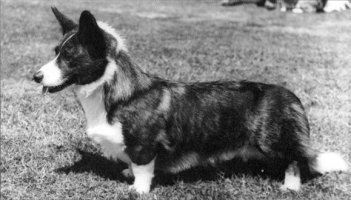Our Dogs January 1st 2021.
Judging the Boston Terrier. By Peter Clifton.
The breed is known around the world as the American Gentleman, originating in the U.S.A in the late 1880s from crossing the English Bulldog and English Bull terrier and within forty years became the American number one registered breed. The first Boston Terrier came to the U.K in 1901 and quickly gained popularity, and today it is a major player in the Utility group entries.
Apart from the head the Boston should be easy to evaluate, after all the breed does not carry coat to hide faults, that so many other breeds get away with.
The early Boston Terriers were originally called the Round Headed Bull Terrier and have been described in many writings as not very beautiful specimens, but with hindsight they should have been named the Square Headed Boston. The Boston developed, in its early years giving what we have today, an impression of squareness in all departments, elegance with total balance, never bully or resembling the Bulldog or Terrier breed types.
The Boston Terrier is a table dog and hands on should always be via the table, failure to observe this could result in a Boston jumping into your arms. Always approach from the front for Boston's are extremely inquisitive to everything around them and patience can often be called for by judges and handlers. Markings can give even the experience judge an optical illusion and it should always be acceptable to view on table or floor any exhibit from the opposite side should one feel markings are creating something that’s not true.
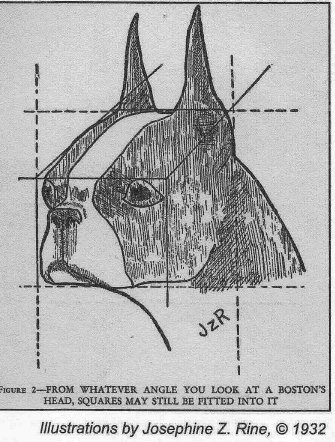
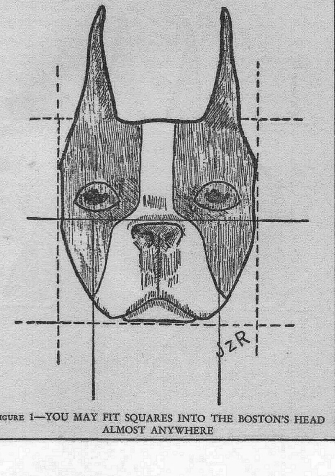
Many around the world refer to the breed as a head breed and while this is an important characteristic of the breed one should never loose sight that like, in any breed, one must judge evaluating the complete dog on merits rather than faults.
The classic Boston head should fit into a drawn lined square from any angle fig 1,and 2, and in proportion to dogs overall size and balance. Skull flat and free of wrinkles with ears set near to the corners of skull as possible, thus adding to the overall squareness of head. The standard calls a defined stop and muzzle square, wide and deep, underjaw broad, bite even or sufficiently undershot to square muzzle, wry mouth and tongue showing with mouth closed are undesirable. Muzzle relatively shorter in length than width and depth, and may be up to one-third of the length of the skull. Some judges over recent times have made reference to a personal preference for a longer nose and criticised some exhibits for being too short in nose. Whilst we all may well have our own personnel preferences we are expected, by exhibitors, to judge to the breed standard, and one does need to
understand and take into consideration the length comes from tip of nose to the base of the defined stop. While the breed standard calls for the head and skull to be free of wrinkles the American education material states this should not be confused with little creases, maybe a small ridge would be a more adept wording to cover this point. The final part of the Boston head that contributes so much to that special look, are the eyes which should be set square, outer corner on a line of cheek, dark, always round, and set square. The Boston head is unlike all others breeds, it is unique, so forget your knowledge of other bull breeds, for failing to do so will do immense damage to this wonderful breed, so remember one of squareness, elegance, kindness and a lovable cockiness expression that melts ones heart.
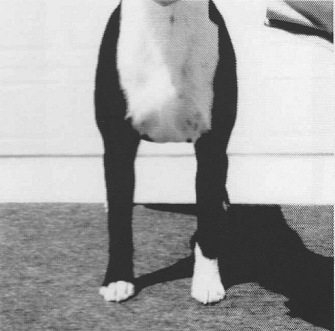
From front on (fig 3) the legs are straight, moderately set apart, elbows fitting close to body. Bone moderate and fitting overall size and sex. Short pasterns, feet facing straight ahead (which means not turning in or out) round, arched and compact. The Boston front is one of refinement and should never be overloaded in shoulder.
The hindquarters (fig 4) have angulated turn of stifle, and without anything looking out of proportion, appearing strong, never weak, well muscled and capable of moving itself forward with grace and power. When viewed from the rear, feet point straight ahead in line with front. Hindquarters should be easy to understand for the problems are so easy to see, from the lack of angulation to over angulation which all lead to many other undesirable and often seen faults in this and many other breeds these days. Ones hands on the legs will easy indicate muscle tone along with signs of patella luxation. The later being a serious health issue.
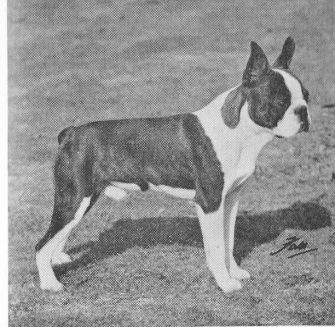
In side profile (photo 5) one should look to find squareness and overall balance. Neck slightly arched, never so short to appear stocky, or overlong giving that race dog appearance and remember that it is a very important factor of overall balance. The neck slopes gently into the withers and not into a clean cut L shaped join into the shoulder. Also one should hope to see a line raising upwards from point of elbow passing out via the
withers. Get both those correct and one is well on the way to good shoulder placement. The Boston should be short in back to provide the required squareness, and the word level, which is an important factor in the breeds squareness and elegance should be applied only from withers to the gentle slope of the rump. The adult body should be deep, approx to point of elbow, with a slight tuck up, ribs well laid back and short in loin . Recent times have seen short ribbing come into the breed and while this in itself is a fault, it makes the animal long in loin along with a tendency to appear unbalanced via being long in back.
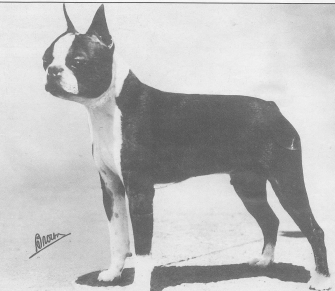
The rump should curve slightly to the tail set thus making it lower than the withers. The side profile picture (photos 6-7) should show clean lines, front legs under and supporting body and rear legs, tip of toes in line approx with tail. The side profile should not picture over angulation, hind feet in the next county or sloping topline. This modern trend of exaggeration has become so noticeable in this and many other breeds over recent years.
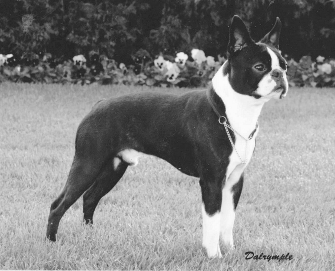
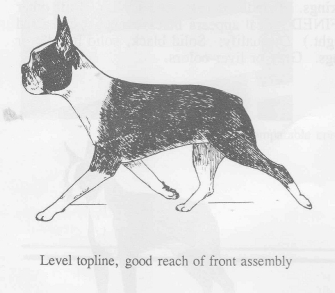
The Boston certainly is very active, inquisitive, full of enthusiasm and energy thus making some extremely difficult to ascertain when on the move and sometimes soundly constructed dogs can look anything but correct on the move.
So please be patient, never be afraid to cross to the other side of the ring should an exhibit move correctly one way, and like a complete idiot the other. All dogs move there best at different speeds and while this should be allowed, running with this breed is really a step too far.
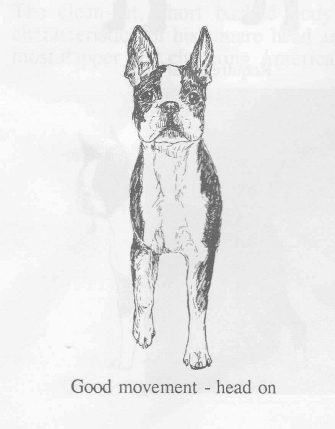
In side profile movement, the topline should remain firm and level, along with balanced reach and drive
The Boston size is governed by three weights, lightweight under 15lbs Middleweight 15-20lbs and heavyweight 20-25lbs. I have yet to see any judge weigh the breed, but it would be quite interesting to know how many have any idea what weight dogs sit at when judging. One must always remember that all weights are equal and personal preference on size must not influence ones judging.
Judging is about giving a personal opinion on just the day of the show, in a year or two time you may judge the same dogs quite differently, Remember also the Boston like with any breed, outdoor grass should not contribute, or take away from the breeds squareness or balance, it can how ever create an illusion to the eye, thus always remember your early vision of exhibits on the table.
Many and this includes some from within the breed admit its not an easy breed to judge, mainly due to the vast diversity exhibited. Many feel that you must live with the breed to fully understand the meaning of the true classic Boston head and expression.
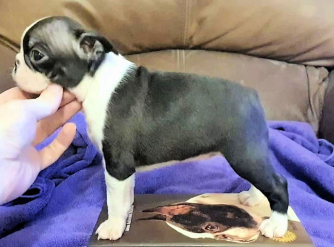
Whatever your feelings, a walk back down memory lane will give a much better understanding of the Boston history, its failures and virtues, and just possibly make us all better judges that could well ensure we leave this wonderful breed in a better state for the next generation.
